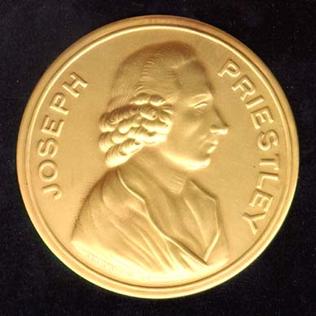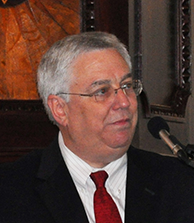Related Research Articles

Bromine is a chemical element with the symbol Br and atomic number 35. It is a volatile red-brown liquid at room temperature that evaporates readily to form a similarly coloured vapour. Its properties are intermediate between those of chlorine and iodine. Isolated independently by two chemists, Carl Jacob Löwig and Antoine Jérôme Balard, its name was derived from the Ancient Greek βρῶμος (bromos) meaning "stench", referring to its sharp and pungent smell.

The Dow Chemical Company, officially Dow Inc., is an American multinational corporation headquartered in Midland, Michigan, United States. The company is among the three largest chemical producers in the world.

Ipratropium bromide, sold under the trade name Atrovent among others, is a type of anticholinergic medication which opens up the medium and large airways in the lungs. It is used to treat the symptoms of chronic obstructive pulmonary disease and asthma. It is used by inhaler or nebulizer. Onset of action is typically within 15 to 30 minutes and lasts for three to five hours.

Sir John Warcup Cornforth Jr., was an Australian–British chemist who won the Nobel Prize in Chemistry in 1975 for his work on the stereochemistry of enzyme-catalysed reactions, becoming the only Nobel laureate born in New South Wales.

Jacqueline K. Barton, is an American chemist. She worked as a Professor of Chemistry at Hunter College (1980–82), and at Columbia University (1983–89) before joining the California Institute of Technology. In 1997 she became the Arthur and Marian Hanisch Memorial Professor of Chemistry and from 2009 to 2019, the Norman Davidson Leadership Chair of the Division of Chemistry and Chemical Engineering at Caltech. She currently is the John G. Kirkwood and Arthur A. Noyes Professor of Chemistry.
Sir Derek Harold Richard Barton was an English organic chemist and Nobel Prize laureate for 1969.

The Priestley Medal is the highest honor conferred by the American Chemical Society (ACS) and is awarded for distinguished service in the field of chemistry. Established in 1922, the award is named after Joseph Priestley, the discoverer of oxygen who immigrated to the United States of America in 1794. The ACS formed in 1876, spearheaded by a group of chemists who had met two years previously in Priestley's home.

Robert Howard GrubbsForMemRS was an American chemist and the Victor and Elizabeth Atkins Professor of Chemistry at the California Institute of Technology in Pasadena, California. He was a co-recipient of the 2005 Nobel Prize in Chemistry for his work on olefin metathesis.
Gilbert Stork was an organic chemist. For a quarter of a century he was the Eugene Higgins Professor of Chemistry Emeritus at Columbia University. He is known for making significant contributions to the total synthesis of natural products, including a lifelong fascination with the synthesis of quinine. In so doing he also made a number of contributions to mechanistic understanding of reactions, and performed pioneering work on enamine chemistry, leading to development of the Stork enamine alkylation. It is believed he was responsible for the first planned stereocontrolled synthesis as well as the first natural product to be synthesised with high stereoselectivity.

2-Bromopropane, also known as isopropyl bromide and 2-propyl bromide, is the halogenated hydrocarbon with the formula CH3CHBrCH3. It is a colorless liquid. It is used for introducing the isopropyl functional group in organic synthesis. 2-Bromopropane is prepared by heating isopropanol with hydrobromic acid.
Isopropyl alcohol is a colorless, flammable organic compound with a pungent alcoholic odor. As an isopropyl group linked to a hydroxyl group it is the simplest example of a secondary alcohol, where the alcohol carbon atom is attached to two other carbon atoms. It is a structural isomer of propan-1-ol and ethyl methyl ether.
Milton C. Whitaker (1870-1963) was a noted 20th-century chemist. His areas of speciality were chemical engineering and industrial chemistry.

Richard Mark Gergel is a South Carolina lawyer and United States district judge of the United States District Court for the District of South Carolina.
Derek Lowe is a medicinal chemist working on preclinical drug discovery in the pharmaceutical industry. Lowe has published a blog about this field, "In the Pipeline", since 2002 and is a columnist for the Royal Society of Chemistry's Chemistry World.

Thioacetone is an organosulfur compound belonging to the -thione group called thioketones with a chemical formula (CH3)2CS. It is an unstable orange or brown substance that can be isolated only at low temperatures. Above −20 °C (−4 °F), thioacetone readily converts to a polymer and a trimer, trithioacetone. It has an extremely potent, unpleasant odor, and is considered one of the worst-smelling chemicals known to man.

Dylann Storm Roof is an American white supremacist, neo-Nazi, and mass murderer convicted of perpetrating the Charleston church shooting on June 17, 2015, in the U.S. state of South Carolina. During a Bible study at Emanuel African Methodist Episcopal Church, Roof killed nine people, all African Americans, including senior pastor and state senator Clementa C. Pinckney, and injured a tenth person. After several people identified Roof as the main suspect, he became the center of a manhunt that ended the morning after the shooting with his arrest in Shelby, North Carolina. He later confessed that he committed the shooting in hopes of igniting a race war. Roof's actions in Charleston have been widely described as domestic terrorism.

Alma Levant Hayden was an American chemist, and one of the first African-American women to gain a scientist position at a science agency in Washington, D.C. She joined the National Institutes of Health (NIH) in the 1950s. Hayden graduated from Howard University with a master's degree in chemistry, and became an expert in spectrophotometry, the measurement of how substances absorb light. She published work on infrared and other techniques for analyzing chemicals in a range of journals. Hayden was appointed Chief of the Spectrophotometer Research Branch in the Division of Pharmaceutical Chemistry at the U.S. Food and Drug Administration (FDA) in 1963, and may have been the first African-American scientist at the FDA. Hayden came to national attention in 1963 when she led the team that exposed the common substance in Krebiozen, a long-controversial alternative and expensive drug promoted as anti-cancer.

Kára McCullough Temple is an American beauty pageant titleholder who was crowned Miss USA 2017. As Miss USA, McCullough represented the United States at Miss Universe 2017, where she placed in the top ten.
Ingrid Montes, also known as Ingrid del Carmen Montes González is a full professor in the Department of Chemistry at the University of Puerto Rico, Río Piedras campus. She attained tenure in 1998. Her research focus is on chemical education and organometallic chemistry. Montes has been Director-at-large at the American Chemical Society (ACS) since 2013. Montes founded the "Festival de Química" in 2005, this program was then adopted by the ACS in 2010.
References
- ↑ Stinso, Stephen C. (1986). "Adventures in Making Fine Chemicals". Chemical & Engineering News. American Chemical Society. 64 (31): 23–24. doi:10.1021/cen-v064n031.p023.
- ↑ "Looking Back — Max Gergel" (PDF). USC Chemist. Department of Chemistry and Biochemistry College of Arts and Sciences University of South Carolina. 2005. Archived from the original (PDF) on September 23, 2015.
- ↑ "Advisors". Arkalon Chemical Technologies, LLC. Archived from the original on April 2, 2015.
- ↑ Berger, Eric (July 16, 2017). "96-Year-Old South Carolina Man's Last Mitzvah: A Bar Mitzvah". Chabad-Lubavitch News. Retrieved August 15, 2017.
- ↑ Gergel, Max (1977). Excuse Me Sir, Would You Like to Buy a Kilo of Isopropyl Bromide? (PDF). Pierce Chemical Company.
- ↑ Lowe, Derek (May 27, 2010). "Max Gergel's Memoirs". Corante. Archived from the original on September 5, 2015.